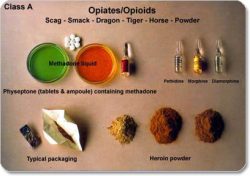Opiates comprise a wide spectrum of drugs, most all of which are known for their pain-relieving effects. From simple muscle aches and pains to chronic pain-related conditions, drugs on the opiates list address most every type of pain symptom a person can experience.
Natural substances, synthetic drugs and semisynthetic drugs all make up the various categories that appear on an opiates list. Having an understanding of how drugs on an opiates list work can come in handy for someone wanting to lessen the likelihood of abuse or addiction, especially in cases where a long-term pain treatment is needed.
What Are Opiates?

Opiates all stem from the opium poppy seed plant.
The fundamental chemical structure for the vast number of opiate drugs in existence comes from one single plant: the opium poppy seed plant. According to Princeton University, the opium poppy seed plant contains in excess of 50 different alkaloids or organic compounds known to produce certain effects in the body. Of these 50 alkaloid compounds, 25 of them carry pain-relieving properties.
The human body contains its own opiate system made up of cell receptor sites located in the brain, central nervous system and gastrointestinal tract. These sites secrete endorphin-like chemicals that work to modulate pain sensations throughout the body.
In terms of chemical structure, opiates and the body’s endorphin chemicals bear a striking similarity, which accounts why opiates work so well at relieving pain symptoms. Most all drugs included on the opiates list interact with the body’s cell receptor sites in the same way.
Opiates List Categories
Natural Opiates
The natural drugs contained on the opiates list come from the alkaloid materials found in the opium poppy seed plant. Natural opiate drug types include –
- Codeine
- Morphine
- Oripavine
- Thebaine
Opium poppy seed plants contain a high concentration of morphine-derived alkaloids, which accounts for why morphine is one of the strongest opiates in existence. Codeine-derived alkaloids make up the second highest concentration.
Technically speaking, only natural opiates quality as actual opiate drugs; however, any drug derived and/or synthesized to act as an opiate material falls within the opiates list.
Synthetic Opiate Drugs
The synthetic opiates list contains a wide assortment of manufactured drugs, each of which targets different intensities and types of pain symptoms. Though manufactured to resemble natural alkaloid substances, synthetic drug formulations can carry considerably higher potencies than natural alkaloids.
Synthetic opiate drug types include –
- Lortab
- Demerol
- Atarax
- Dilaudid
- Fentanyl
Synthetic opiates also include five of the most often prescribed opiate addiction treatment drugs –
- Methadone
- Suboxone
- Subutex
- Naltrexone
- Naloxone
Whereas methadone, Suboxone and Subutex act as substitutes for addictive opiates, naltrexone blocks opiates from stimulating cell receptor sites while naloxone expels existing opiate materials from cell sites.
Semisynthetic Opiates
Semisynthetic opiates contain small amounts of natural opium alkaloids combined with synthetic agents. The semisynthetic opiates list includes the following drugs –
- Oxycodone
- Oxymorphone
- Hydromorphone
- Hydrocodone
Natural alkaloids used in the making of semisynthetic opiates include –
- Codeine – for hydrocodone
- Morphine – for hydromorphone
- Thebaine – for oxymorphone and oxycodone
In effect, the ability to manufacture opiate-like drugs has greatly contributed to the number of pain treatment options available.









